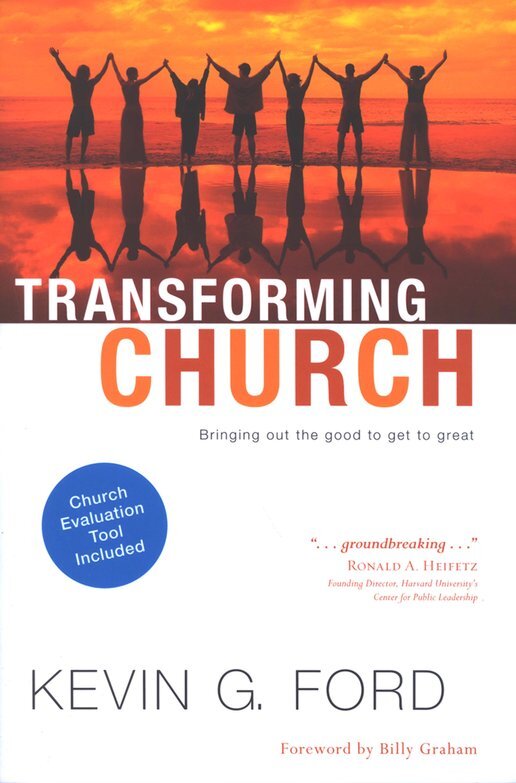Kevin Ford, Transforming Church: Bringing Out the Good to Great. David C. Cook Publishing, 2008.
- Leadership Approaches: Adaptive Leadership, Ron Heifetz
- Strategies for Congregational Renewal: Diagnostic/Prescriptive
LifeandLeadership.com Summary
It may seem from the subtitle that this planning approach builds on the concepts of Jim Collins’ popular Good to Great. The authors do mention Collins, but the primary theoretical base for this volume is Ron Heifetz adaptive vs. technical leadership. Ford begins by denouncing quick-fix approaches to church transformation, or the illusory busy-work of addressing “technical” (tangible, fixable, manageable) problems as opposed to the more important and underlying “adaptive” (complex, deep-seated, seriously challenging) issues. He writes the book for churches that “have the courage to embrace change and to confront adaptive issues head on.” (19)
The tool for Ford’s process is a congregational survey, the Transformative Church Index. Research using the index, as described in the appendix, revealed “five key indicators of church health, with each indicator representing a fork in the road on the journey of change.” The tracks of the journey “are not sequential, yet they cannot be separated. In fact, by concentrating on one, you will address them all.” (20) He weaves the discussion of these health indicators around the stories of a wide diversity of real churches, with the primary narratives focused on five congregations that have been through the journey with Ford and his consultative team. The book presents the five health indicators, with the discussion of each one followed by “speed bumps” that help leaders reflect back on the principles as they apply to their context. These include “transforming church checkups” for evaluating one’s church in light of the health indicators, alongside “travel tips” and “reflections” to help navigate the transformative journey.
The five key health indicators are presented in contrast to the five leading dysfunctions.
1. Consumerism vs. Community – How churches relate to one another. Unhealthy churches are a collection of people acting individually, while healthy churches relate as a community.
2. Incongruence vs. Code – The church’s “genetic code.” Unhealthy churches lack a clear identity, while healthy churches have a clear sense of their DNA and take steps to align their ministries and culture with their code.
3. Autocracy vs. Shared Leadership – Unhealthy churches tend to be overly autocratic or bureaucratic, while healthy churches view leadership as a shared function and as a ministry.
4. Cloister vs. Missional – How the church relates to the local community. Unhealthy churches disengage from the world around them, while healthy churches are focused on their mission and have an outward orientation that starts with their own locale.
5. Inertia vs. Reinvention – How church members think about the future. Unhealthy churches resist change and fear or deny the future, while healthy churches embrace change, even when it is painful. (32-33)
Clearly, each dysfunction is correlated to a problem in the larger American culture. Thus instead of transforming culture, the church imbibes its surroundings, often subconsciously and unrecognizably, to such a degree that it loses its essential mission and identity. The adaptive change (cf. Heifetz) required of the church in this situation “is largely a movement along each of the key indicators, from cultural dysfunction to biblical dynamic.” (34)
The book is useful for leaders to assess their ministries in light of these five dysfunctions and health indicators. It operates from a strongly systemic philosophy, i.e. not a sequential, step-by-step procedure, but a tool for beginning with any of the five dimensions. Change in one leads to change in the others. For example, in the section on Incongruence vs. Code, they discuss how leaders can discover their code by looking at the congregation’s symbols that come in four primary forms: myths, rituals, heroes, and visuals. (115) Armed with this understanding, they can more effectively craft core values and mission that are congruent with and flow out of code. (120) Obviously, however, this has implications for another of the indicators, autocracy vs. shared leadership, as well as the churches conceive of their relationship to the surrounding community, cloistered vs. missional.
Churches using Ford’s approach would need to be convinced of the adequacy of the five indicators as a basis for evaluating effectiveness. This model lacks the comprehensiveness of a full-blown diagnostic, but it is hard to imagine any ministry assessment that would not include the five key indicators. Ford is excellent for this aspect of the planning process.
From the Publisher
The mission of the church is change-to partner with God to transform lives. But in order to change people, ministries must first manage and lead change from within.
Too often churches are unable to reform and revise their approach to ministry. Declining churches need to rebuild. Stagnant ministries must pursue the next level. Even growing congregations can struggle to keep up with the pace of change. So why do so many churches fail to adapt? How can ministries envision, implement, and evaluate effective change?
Kevin G. Ford has the powerful answers. As a consultant to ministries across the country, Ford has helped hundreds of churches experience genuine change and growth. Filled with eye-opening insights, Transforming Church identifies five dysfunctions of an unhealthy church, and shares the five key indicators of a healthy, vibrant congregation. You’ll discover the keys for creating a church that transforms lives, your community, and the world.
About the Author
Kevin Ford is the chief visionary officer and managing partner of TAG Consulting, a business and organizational consulting firm. Through TAG Consulting, he has facilitated the development of over 400 strategic action plans that have transformed organizations throughout North America. Kevin, his wife Caroline, and their two daughters reside in northern Virginia.
***For additional information on this resource, including reviews, click the bookstore links. Check the reference at page top or the links below for resource guides on related topics.***
See Resources on Over 100 Areas of Ministry Leadership:


